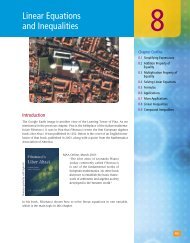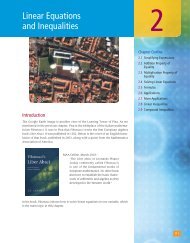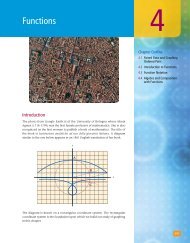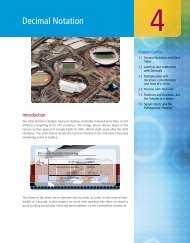Chapter 9 - XYZ Custom Plus
Chapter 9 - XYZ Custom Plus
Chapter 9 - XYZ Custom Plus
You also want an ePaper? Increase the reach of your titles
YUMPU automatically turns print PDFs into web optimized ePapers that Google loves.
9.4 Linear Equations in One Variable<br />
541<br />
B<br />
Equations Involving Fractions<br />
We will now solve some equations that involve fractions. Because integers are<br />
usually easier to work with than fractions, we will begin each problem by clearing<br />
the equation we are trying to solve of all fractions. To do this, we will use the<br />
multiplication property of equality to multiply each side of the equation by the<br />
LCD for all fractions appearing in the equation. Here is an example.<br />
Example 5<br />
Solve the equation } 2<br />
x } 1 }6<br />
x } 5 8.<br />
5. Solve: } 3<br />
x } 1 }6<br />
x } 5 9<br />
x x<br />
Solution The LCD for the fractions } } 2 and }6 } is 6. It has the property that both<br />
2 and 6 divide it evenly. Therefore, if we multiply both sides of the equation by 6,<br />
we will be left with an equation that does not involve fractions.<br />
6 1<br />
} 2<br />
x } 1 }6<br />
x }2 5 6(8) Multiply each side by 6<br />
6 1<br />
} 2<br />
x }2 1 6 1<br />
} 6<br />
x }2 5 6(8) Apply the distributive property<br />
3x 1 x 5 48 Multiplication<br />
4x 5 48 Combine similar terms<br />
x 5 12 Divide each side by 4<br />
We could check our solution by substituting 12 for x in the original equation. If<br />
we do so, the result is a true statement. The solution is 12.<br />
As you can see from Example 5, the most important step in solving an equation<br />
that involves fractions is the first step. In that first step we multiply both sides of<br />
the equation by the LCD for all the fractions in the equation. After we have done<br />
so, the equation is clear of fractions because the LCD has the property that all the<br />
denominators divide it evenly.<br />
Example 6<br />
Solve the equation 2x 1 } 1 2 } 5 }3 4 }.<br />
6. Solve: 3x 1 } 1 4 } 5 }5 8 }<br />
Solution<br />
This time the LCD is 4. We begin by multiplying both sides of the<br />
equation by 4 to clear the equation of fractions.<br />
4 1<br />
2x 1 } 1 2 } 2 5 4 1 }3 4 } 2<br />
4(2x) 1 4 1<br />
} 1 2 } 2 5 4 1 }3 4 } 2<br />
8x 1 2 5 3<br />
8x 5 1<br />
Multiply each side by the LCD, 4<br />
Apply the distributive property<br />
Multiplication<br />
Add 22 to each side<br />
x 5 } 1 } Divide each side by 8<br />
8<br />
7. Solve: } 4 x } 1 3 5 }1 1<br />
}<br />
5<br />
Example 7<br />
Solve for x: } 3 x } 1 2 5 }1 }. (Assume x is not 0.)<br />
2<br />
Solution This time the LCD is 2x. Following the steps we used in Examples 5<br />
and 6, we have<br />
2x 1<br />
} 3 x } 1 2 2 5 2x 1 }1 2 } 2<br />
Multiply through by the LCD, 2x<br />
2x 1<br />
} 3 x } 2 1 2x(2) 5 2x 1 }1 2 } 2<br />
Distributive property<br />
6 1 4x 5 x Multiplication<br />
6 5 23x Add 24x to each side<br />
22 5 x Divide each side by 23<br />
Answers<br />
5. 18 6. } 1 } 7. 25<br />
8

















